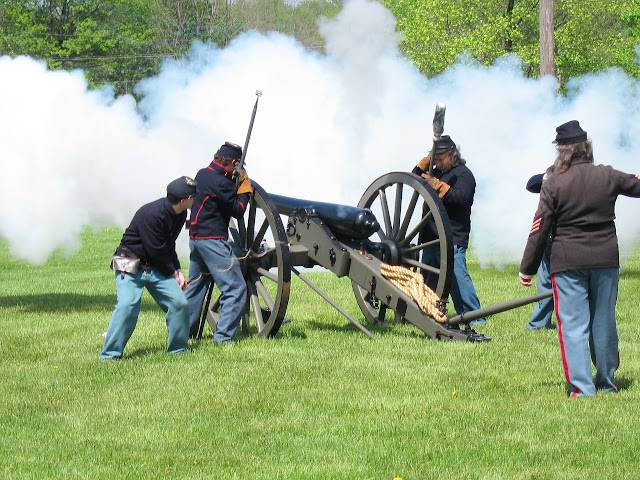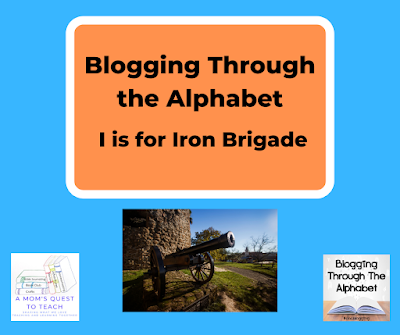This post contains affiliate links. For more information, please see my Terms of Use and Disclosure Policy page. Thank you.
The Iron Brigade was one of the many nicknames for an infantry brigade in the Army of the Potomac during the American Civil War. They were formed on October 1, 1861, with the following regiments falling under the command of Brigadier General Rufus King: 7th Wisconsin, 2nd Wisconsin, 6th Wisconsin, and the 19th Indiana. They were also called the Black Hats due to their 1858 black-felt Hardee hats which caused the Westerners to look even taller and made them extremely distinguishable among the soldiers in the army and they were also called the King's Wisconsin Brigade. In addition to the broad-brimmed, high-crowned Hardee hats, they wore thigh-length frock coats in the field. The Iron Brigade, an all-western brigade, had the reputation of one of the best units in the army.
In addition to being the only all-western brigade to serve in the Eastern army on the Eastern front, they also suffered the highest percentage of casualties of any brigade in the American Civil War by the end of the war. For example, they suffered a 60% casualty rate at the Battle of Gettysburg. One thousand one hundred fifty-three were killed or wounded out of one thousand eight hundred eighty-five who participated in the battle. The all-Virginia Stonewall Brigade had the same distinction within the Confederate army of suffering the highest percentages of casualties.
Some of the battles in which the Iron Brigade fought include Bull Run, Antietam, Fredericksburg, and Gettysburg. They earned their distinctive nickname at the Battle at South Mountain in 1862.
 |
| image by: Wendy Luby from Pixabay |
Antietam
At the Battle of Antietam, the Iron Brigade saw great frenzy on the battlefield. They were at the forefront of the opening attack. The 6th Wisconsin, part of the Iron Brigade, had 40 men killed and 112 wounded out of the 300 men engaged in the battle. In general, it was stated that they had only 400 to 500 left out of the 2500 men who were marching with the Brigade two months prior to Antietam. The men proudly stated that there were no sick men nor any stragglers. There were no cowards. The men who were not present had either died or were wounded on the battlefield.
Gettysburg
 During the Battle of Gettysburg the Iron Brigade (or the Black Hats) was one of the hardest fighting. Perhaps, they were the hardest fighting outfit in the Army of the Potomac. The Iron Brigade was the 1st Brigade of the 1st Division of the I Army Corps. They were part of Reynolds' division that helped push back the Confederates on the morning of the first day.
During the Battle of Gettysburg the Iron Brigade (or the Black Hats) was one of the hardest fighting. Perhaps, they were the hardest fighting outfit in the Army of the Potomac. The Iron Brigade was the 1st Brigade of the 1st Division of the I Army Corps. They were part of Reynolds' division that helped push back the Confederates on the morning of the first day.On July 1, 1863, the Confederates were in the woods, on the other side of McPherson's ridge. The Iron Brigade was along Emmitsburg Road and they marched towards the Lutheran Seminary. The five regiments were commanded by Solomon Meredith and moved forward at double-quick to reach the Seminary.
The Iron Brigade moved through Herbst's Woods on the southern side of Cashtown Pike. They would have to move quickly into battle, actually loading and fixing their bayonets on the way.
This history of individual regiments, brigades, and companies can be quite interesting. While researching the Iron Brigade, I was able to learn more about the events of the early morning of July 1, 1863, as well as about the uniforms of the different Union soldiers. I highly recommend researching not only battles and famous leaders during the American Civil War but also regiments like the Iron Brigade.


Wow so interesting. What age is this reading towards?
ReplyDeleteThis post...I would probably say at least middle school if they have read a bit of background history of the Civil War. Whenever one discusses war, I think it depends on the child as to how young you can go.
DeleteThis is fascinating. I also love the idea of blogging thru the alphabet!
ReplyDeleteThanks...if you ever want to join us, please fill free to jump in with any letter and link up.
DeleteI always look forward to these posts! So fun.
ReplyDeleteThank you! That is nice to hear.
DeleteHave you always loved history? I’m just assuming you do because you’re so good at this!
ReplyDeleteI was a history major and then history teacher but have always loved history thanks to my Grandpop and my Mom.
Delete